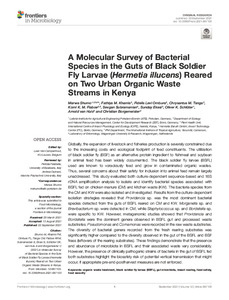| dc.contributor.author | Shumo, M. |
| dc.contributor.author | Khamis, F.M. |
| dc.contributor.author | Ombura, F.L.O. |
| dc.contributor.author | Tanga, C.M. |
| dc.contributor.author | Fiaboe, K. |
| dc.contributor.author | Subramanian, S. |
| dc.contributor.author | Ekesi, S. |
| dc.contributor.author | Schluter, O.K. |
| dc.contributor.author | Huis, A.V. |
| dc.contributor.author | Borgemeister, C. |
| dc.date.accessioned | 2022-09-21T09:55:06Z |
| dc.date.available | 2022-09-21T09:55:06Z |
| dc.date.issued | 2021-09-22 |
| dc.identifier.citation | Shumo, M., Khamis, F.M., Ombura, F.L.O., Tanga, C.M., Fiaboe, K., Subramanian, S., ... & Borgemeister, C. (2021). A molecular survey of bacterial species in the guts of black soldier fly larvae (Hermetia illucens) reared on two urban organic waste streams in Kenya. Frontiers in Microbiology, 12: 687103, 1-15. |
| dc.identifier.issn | 1664-302X |
| dc.identifier.uri | https://hdl.handle.net/20.500.12478/7788 |
| dc.description.abstract | Globally, the expansion of livestock and fisheries production is severely constrained due to the increasing costs and ecological footprint of feed constituents. The utilization of black soldier fly (BSF) as an alternative protein ingredient to fishmeal and soybean in animal feed has been widely documented. The black soldier fly larvae (BSFL) used are known to voraciously feed and grow in contaminated organic wastes. Thus, several concerns about their safety for inclusion into animal feed remain largely unaddressed. This study evaluated both culture-dependent sequence-based and 16S rDNA amplification analysis to isolate and identify bacterial species associated with BSFL fed on chicken manure (CM) and kitchen waste (KW). The bacteria species from the CM and KW were also isolated and investigated. Results from the culture-dependent isolation strategies revealed that Providencia sp. was the most dominant bacterial species detected from the guts of BSFL reared on CM and KW. Morganella sp. and Brevibacterium sp. were detected in CM, while Staphylococcus sp. and Bordetella sp. were specific to KW. However, metagenomic studies showed that Providencia and Bordetella were the dominant genera observed in BSFL gut and processed waste substrates. Pseudomonas and Comamonas were recorded in the raw waste substrates. The diversity of bacterial genera recorded from the fresh rearing substrates was significantly higher compared to the diversity observed in the gut of the BSFL and BSF frass (leftovers of the rearing substrates). These findings demonstrate that the presence and abundance of microbiota in BSFL and their associated waste vary considerably. However, the presence of clinically pathogenic strains of bacteria in the gut of BSFL fed both substrates highlight the biosafety risk of potential vertical transmission that might occur, if appropriate pre-and-postharvest measures are not enforced. |
| dc.description.sponsorship | Canadian International Development Research Centre |
| dc.description.sponsorship | Australian Centre for International Agricultural Research |
| dc.description.sponsorship | German Ministry of Economic Cooperation and Development |
| dc.description.sponsorship | Netherlands Organization for Scientific Research |
| dc.description.sponsorship | International Centre of Insect Physiology and Ecology |
| dc.description.sponsorship | UK Aid |
| dc.description.sponsorship | Swedish International Development Cooperation Agency |
| dc.description.sponsorship | Swiss Agency for Development and Cooperation |
| dc.description.sponsorship | Federal Ministry for Economic Cooperation and Development (BMZ), Germany |
| dc.description.sponsorship | Kenyan Government |
| dc.format.extent | 1-15 |
| dc.language.iso | en |
| dc.subject | Organic Wastes |
| dc.subject | Waste Treatment |
| dc.subject | Hermetia Illucens |
| dc.subject | Microbial Flora |
| dc.subject | Insect Rearing |
| dc.subject | Feed Safety |
| dc.subject | Food Security |
| dc.subject | Kenya |
| dc.title | A molecular survey of bacterial species in the guts of black soldier fly larvae (Hermetia illucens) reared on two urban organic waste streams in Kenya |
| dc.type | Journal Article |
| cg.contributor.affiliation | Leibniz-Institute for Agricultural Engineering Potsdam-Bornim |
| cg.contributor.affiliation | Center for Development Research (ZEF), Germany |
| cg.contributor.affiliation | International Centre of Insect Physiology and Ecology |
| cg.contributor.affiliation | Insect Technology Center (ITC), Germany |
| cg.contributor.affiliation | International Institute of Tropical Agriculture |
| cg.contributor.affiliation | Wageningen University and Research Centre |
| cg.coverage.region | Africa |
| cg.coverage.region | East Africa |
| cg.coverage.country | Kenya |
| cg.coverage.hub | Central Africa Hub |
| cg.identifier.bibtexciteid | SHUMO:2021 |
| cg.isijournal | ISI Journal |
| cg.authorship.types | CGIAR and advanced research institute |
| cg.iitasubject | Agronomy |
| cg.iitasubject | Biodiversity |
| cg.iitasubject | Food Security |
| cg.iitasubject | Plant Breeding |
| cg.iitasubject | Plant Diseases |
| cg.iitasubject | Plant Health |
| cg.iitasubject | Plant Production |
| cg.journal | Frontiers in Microbiology |
| cg.notes | Published online: 22 Sep 2021 |
| cg.accessibilitystatus | Open Access |
| cg.reviewstatus | Peer Review |
| cg.usagerightslicense | Creative Commons Attribution 4.0 (CC BY 0.0) |
| cg.targetaudience | Scientists |
| cg.identifier.doi | https://dx.doi.org/10.3389/fmicb.2021.687103 |
| cg.iitaauthor.identifier | Komi Fiaboe: 0000-0001-5113-2159 |
| cg.futureupdate.required | No |
| cg.identifier.volume | 12 |
| cg.contributor.acknowledgements | The authors are extremely thankful to their esteemed colleague Guido Luechters (ZEF) for his valuable assistance in the data
analysis andMaureen Ong’onge, Joseph Gichuhi, Isaiah Rachami, and Dennis Muthoni (ICIPE) for their technical assistance. The authors are also grateful to the reviewers whose comments and suggestions helped shape this manuscript. |

